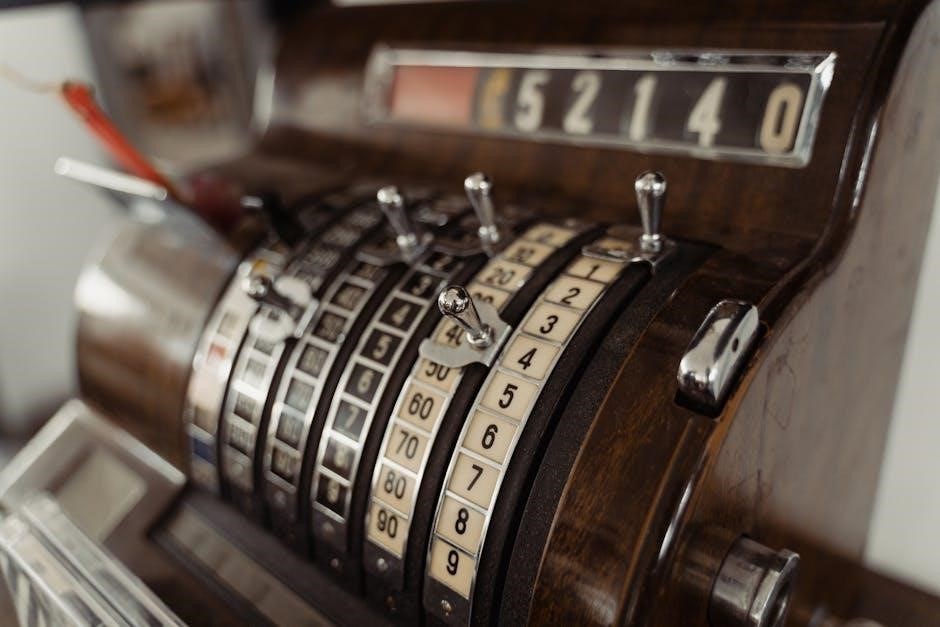A decimal place value chart is a visual tool that helps students understand the decimal system by breaking down numbers into their place values, from whole numbers to decimals.
1.1 What is a Decimal Place Value Chart?
A decimal place value chart is a visual tool that helps students understand the value of each digit in a number, both to the left and right of the decimal point. It breaks down numbers into their place values, such as ones, tens, hundreds, and tenths, hundredths, thousandths. This chart visually represents how the value of a digit changes based on its position, making it easier to grasp the concept of place value in both whole numbers and decimals.
1.2 Importance of Decimal Place Value Charts in Education
Decimal place value charts are essential educational tools that simplify the understanding of complex number concepts. They bridge the gap between whole numbers and decimals, making abstract ideas concrete. By visually organizing place values, these charts enhance students’ ability to perform arithmetic operations and grasp the relationships between digits. They are particularly valuable for visual learners, aiding in the mastery of decimal systems and fostering a strong foundation in mathematics.

Structure of a Decimal Place Value Chart
A decimal place value chart organizes numbers into whole number places (ones, tens, hundreds, thousands) and decimal places (tenths, hundredths, thousandths, millionths), visually representing each digit’s value.
2.1 Whole Number Places (Ones, Tens, Hundreds, Thousands)
Whole number places in a decimal place value chart represent the value of digits from ones to thousands. Starting with ones, each position to the left increases by a factor of 10; Tens represent 10 ones, hundreds 10 tens, and thousands 10 hundreds. This structure helps students visualize how numbers are built and understand the relationship between digits in whole numbers, making operations like addition and subtraction more manageable.
2.2 Decimal Places (Tenths, Hundredths, Thousandths, Millionths)
Decimal places extend beyond the decimal point, representing fractions of a whole. Tenths are the first decimal place, followed by hundredths, thousandths, and millionths. Each position to the right divides the previous value by 10, helping students grasp the diminishing value of digits in decimal numbers. This structure is essential for understanding precision in measurements and calculations involving fractions.
2.3 Visual Representation of Place Values
A decimal place value chart visually organizes whole numbers and decimals, making relationships between digits clear. It aligns whole number places (ones, tens, hundreds) on the left and decimal places (tenths, hundredths, thousandths, millionths) on the right. This symmetry helps students visualize how each digit’s value changes with its position. Distinct sections for each place value simplify identifying the role of each digit in a number, enhancing understanding and practical applications like renaming numbers and performing operations.
Benefits of Using a Decimal Place Value Chart
A decimal place value chart enhances understanding of decimal systems, simplifies operations, and aids the transition from whole numbers to decimals, making it an invaluable educational tool.
3.1 Enhancing Understanding of Decimal Systems
A decimal place value chart provides a clear visual representation of how digits in decimal numbers relate to each other. By organizing numbers into whole and decimal parts, students can better grasp the concept of place value, understanding how tenths, hundredths, and thousandths contribute to the overall value of a number. This visual tool simplifies complex relationships, making decimal systems more accessible and easier to comprehend.
3.2 Simplifying Operations with Decimals
Decimal place value charts simplify operations with decimals by providing a structured format for organizing numbers. This visual tool helps students align digits correctly, ensuring accurate addition and subtraction. By breaking down numbers into their place values, the chart reduces confusion and errors, making operations like renaming numbers and performing calculations more straightforward and manageable for learners of all skill levels.
3.3 Aiding in the Transition from Whole Numbers to Decimals
Decimal place value charts bridge the gap between whole numbers and decimals, helping students understand the relationship between digits. By visually aligning whole number places (ones, tens, hundreds) with decimal places (tenths, hundredths, thousandths), the chart simplifies the transition. This structured approach helps students see how place values extend beyond the decimal point, making it easier to rename and work with numbers in both whole and decimal forms seamlessly.
How to Use a Decimal Place Value Chart
Use the chart to identify place values, rename numbers, and apply the chart for operations like addition, subtraction, division, and multiplication with decimals and whole numbers effectively.
4.1 Identifying Place Values in Decimal Numbers
A decimal place value chart helps students identify the value of each digit in a number by its position. For example, in the number 123.45, the chart shows that 1 is in the hundreds place, 2 in the tens, 3 in the ones, 4 in the tenths, and 5 in the hundredths. This visual representation makes it easier to understand the relationship between whole numbers and decimals, aiding in accurate identification of place values for both.
4.2 Renaming Numbers Using the Chart
The chart aids in renaming numbers by breaking them into place values. For example, 456.78 can be renamed as 400 + 50 + 6 + 0.7 + 0.08, clearly showing each digit’s value. This process enhances understanding of how numbers are structured, making it easier to express them in expanded or word form. The visual representation simplifies the renaming process, ensuring clarity and accuracy for learners.
4.3 Applying the Chart for Addition and Subtraction
The chart is invaluable for adding and subtracting decimals. By aligning numbers according to their place values, students can perform columnar operations accurately. For example, adding 12.34 and 45.67 involves matching tenths and hundredths, ensuring precise calculation. This method minimizes errors and strengthens understanding of how place values interact during arithmetic operations, making it a reliable tool for mastering decimal computations.
4.4 Utilizing the Chart for Division and Multiplication
The chart aids in dividing and multiplying decimals by visually aligning place values. For multiplication, it helps students understand how tenths multiply to hundredths. In division, it clarifies how tenths divide into whole numbers. This alignment ensures accurate calculations and reinforces the relationship between decimal places and fractions, making complex operations more intuitive and error-free for learners at all levels.
Applications of Decimal Place Value Charts
Decimal place value charts are widely used in classrooms, real-world scenarios, and special education. They provide practical tools for teaching, reinforcing decimal understanding, and aiding diverse learning needs effectively.
5.1 Teaching Place Value in Classrooms
Decimal place value charts are invaluable in classrooms for teaching students to understand and visualize decimal systems. They help break down complex concepts into manageable parts, making abstract ideas more concrete. By using these charts, educators can demonstrate how each digit’s value changes as it moves left or right, simplifying operations like addition, subtraction, and renaming numbers. Printable PDF charts are widely available, offering teachers a practical, customizable tool to cater to various skill levels and learning styles, ensuring comprehensive understanding and engagement in math lessons.
5.2 Practical Use in Real-World Scenarios
Decimal place value charts are essential in real-world applications, such as handling money, measuring ingredients, and understanding scientific data. They help individuals manage budgets, calculate discounts, and perform precise measurements in cooking or construction. By visualizing place values, these charts simplify tasks like rounding numbers, converting units, and comparing quantities, making them indispensable tools for everyday problem-solving and decision-making.
5.3 Supporting Special Education Needs
Decimal place value charts are invaluable for students with special education needs, providing a clear, visual structure to understand complex number relationships. These charts break down whole numbers and decimals into manageable parts, aiding students with learning disabilities or visual processing challenges. Customizable PDF charts can be tailored to individual needs, offering a patient and structured approach to mastering place value concepts.

Decimal Place Value Charts in PDF Format
Decimal place value charts are widely available in PDF format, offering a convenient and printable resource for educators. These charts can be easily downloaded and customized to suit specific teaching needs, making them a practical tool for classroom instruction and student practice.
6.1 Availability of Printable PDF Charts
Printable decimal place value charts in PDF format are widely available online. They can be downloaded for free from educational websites like The Curriculum Corner. These charts are designed for easy printing and classroom use. Many PDF charts are customizable, allowing educators to tailor them to specific lesson plans or student needs. This accessibility makes them a valuable resource for teaching and learning decimal place values effectively.
6.2 Customizing Charts for Specific Needs
Decimal place value charts in PDF format can be customized to meet specific educational needs. Educators can modify the range of place values, add examples, or highlight particular concepts. Many websites offer editable versions in Word or Excel, allowing teachers to tailor charts for different grade levels or learning objectives. Customization enhances engagement and ensures the material aligns with classroom goals, making it more effective for individualized instruction;
6.3 Benefits of PDF Formats for Educators
PDF formats of decimal place value charts offer numerous benefits for educators. They are easily printable, ensuring high-quality visuals for classroom use. PDFs are also shareable and accessible across devices, making them ideal for digital classrooms. Additionally, PDF charts can be saved and reused year after year, providing a cost-effective and sustainable resource for teaching place value concepts to students of all ages.

Visual Aids and Supplementary Materials
Visual aids like number lines and place value charts complement learning by providing a tangible representation of decimal concepts. Supplementary materials, such as worksheets and manipulatives, enhance engagement and understanding.
7.1 Number Lines for Decimal Understanding
Number lines are powerful visual tools that help students grasp decimal concepts by displaying numerical relationships. They show progression and intervals, making abstract ideas like tenths, hundredths, and thousandths tangible. By marking decimal points on a line, students can visualize increments and comparisons, enhancing their understanding of place value and operations.
These tools are particularly effective for teaching addition, subtraction, and equivalence. For example, students can see how 0.4 equals 0.40 or how 0.5 is halfway between 0 and 1. Number lines also support fraction-decimal connections, making them versatile aids for diverse learning needs and styles.
7.2 Combining Charts with Other Teaching Tools
Combining decimal place value charts with manipulatives, number lines, and real-world examples enhances learning. For instance, using base-ten blocks alongside charts helps students visualize place value transitions. Interactive activities, such as matching games or problem-solving tasks, further reinforce concepts. This integrated approach ensures a comprehensive understanding of decimals and their applications.
Such combinations cater to diverse learning styles, making abstract ideas more accessible and engaging for students. They also support practical application of skills, bridging the gap between theory and real-world scenarios.

Exercises and Worksheets
Printable worksheets and exercises provide hands-on practice with decimal place value charts, offering opportunities to apply skills and reinforce understanding through structured activities.
8.1 Printable Worksheets for Practice
Printable worksheets offer structured practice with decimal place value charts, helping students apply their knowledge. These exercises cater to various skill levels, providing valuable practice opportunities. Available in PDF and Word formats, they can be easily downloaded and printed. Worksheets focus on identifying place values, renaming numbers, and performing operations with decimals. They are ideal for classroom or home use, reinforcing learning through hands-on activities.
8.2 Interactive Activities for Engagement
Interactive activities enhance learning by making place value practice dynamic and fun. Tools like online quizzes, games, and digital whiteboard exercises engage students, fostering deeper understanding. These activities often include real-time feedback, encouraging immediate correction of mistakes. Collaborative tasks and competitions further motivate learners, creating an enjoyable environment for mastering decimal place value concepts. Digital platforms offer versatile and accessible ways to practice, catering to diverse learning styles and preferences.
Common Misconceptions and Solutions
Students often confuse the value of digits when moving between whole numbers and decimals. Using visual aids like charts helps clarify these relationships and correct misunderstandings effectively.
9.1 Addressing Student Misunderstandings
Students often struggle with understanding how place values shift when moving from whole numbers to decimals. A common misconception is confusing tenths with hundredths. Using a decimal place value chart, educators can visually demonstrate how each digit’s value changes as it moves left or right of the decimal point. This tool helps students recognize the symmetry between whole number places and decimal places, addressing misunderstandings effectively.
9.2 Strategies to Reinforce Learning
To reinforce learning, educators can use interactive activities, such as number lines and real-world examples, to deepen students’ understanding of decimal place values. Incorporating printable worksheets and games ensures consistent practice. Visual aids, like decimal place value charts, help students connect concepts visually, while group discussions encourage collaborative problem-solving. These strategies prevent misunderstandings and build a strong foundation for advanced math skills.

The Future of Decimal Place Value Charts
The future of decimal place value charts lies in interactive digital versions and educational apps, enhancing engagement and accessibility for learners of all levels.
10.1 Digital and Interactive Versions
Digital and interactive versions of decimal place value charts are transforming education, offering engaging tools for students to explore place value concepts dynamically. These tools often include animations, drag-and-drop features, and real-time feedback, making learning more immersive. Interactive charts can also incorporate gamification, allowing students to practice place value through simulations and activities. This shift toward digital solutions enhances accessibility and cater to diverse learning styles, fostering deeper understanding and retention.
10.2 Integrating Technology for Enhanced Learning
Integrating technology enhances learning by providing interactive and dynamic tools for understanding place value. Interactive PDFs and online platforms allow students to explore decimal charts digitally, with features like zoom, real-time updates, and interactive elements. These tools enable personalized learning, making concepts like tenths and hundredths more accessible. Technology also supports differentiated instruction, catering to diverse learning needs and preferences, and fostering engagement through interactive activities and simulations. This integration modernizes education, preparing students for a tech-driven future while reinforcing foundational math skills.
Decimal place value charts are essential tools for understanding decimal systems, simplifying operations, and aiding transitions from whole numbers. Their versatility in PDF and digital formats enhances learning and accessibility for all students.
11.1 Summary of Key Points
Decimal place value charts are versatile tools that help students visualize and understand the decimal system. They break down numbers into whole and decimal parts, making complex concepts easier to grasp. Available in PDF formats, these charts are customizable and widely used in classrooms. They support real-world applications, special education needs, and serve as invaluable teaching aids for fostering mathematical literacy and problem-solving skills.
11.2 Final Thoughts on the Importance of Decimal Place Value Charts
Decimal place value charts are invaluable for building mathematical literacy. They simplify complex concepts, enhance understanding, and provide a bridge between whole numbers and decimals. Their versatility in education and real-world applications makes them indispensable tools for teachers and learners alike, fostering confidence and proficiency in working with decimals and place values.